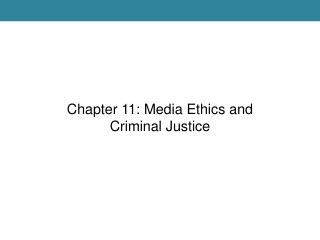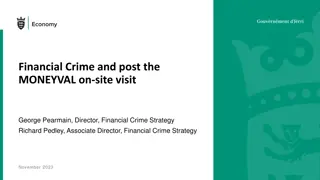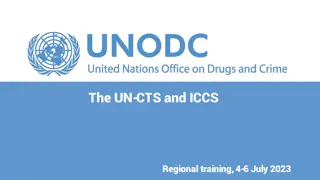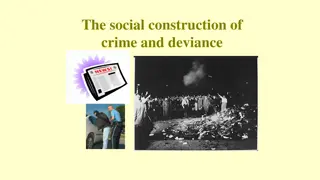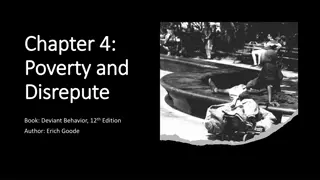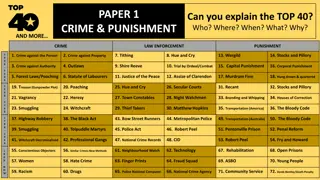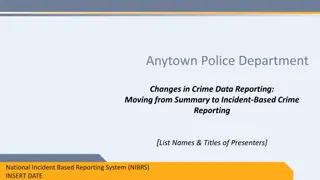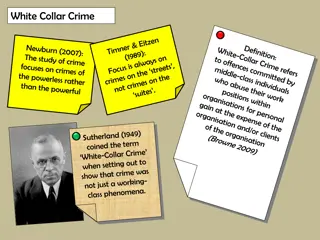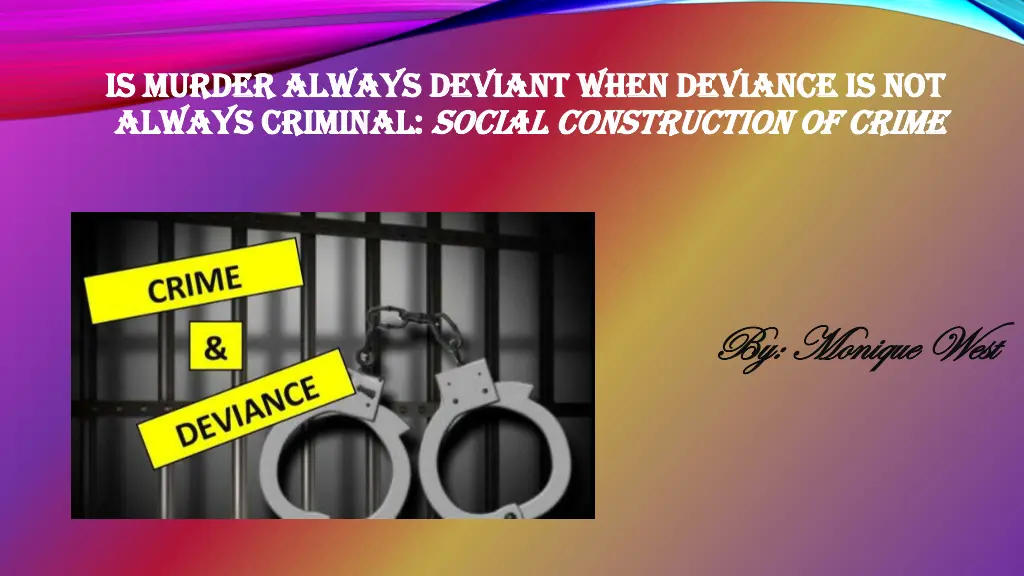
Understanding the Social Construction of Crime and Deviance
Delve into the social constructs of crime and deviance, exploring how society defines and interprets these concepts based on culture and values. Discover the nuances between formal and informal deviant behaviors, as well as the complex relationship between deviance and criminality. Explore the question of whether murder is always considered deviant and the role of causation in criminal law.
Download Presentation

Please find below an Image/Link to download the presentation.
The content on the website is provided AS IS for your information and personal use only. It may not be sold, licensed, or shared on other websites without obtaining consent from the author. If you encounter any issues during the download, it is possible that the publisher has removed the file from their server.
You are allowed to download the files provided on this website for personal or commercial use, subject to the condition that they are used lawfully. All files are the property of their respective owners.
The content on the website is provided AS IS for your information and personal use only. It may not be sold, licensed, or shared on other websites without obtaining consent from the author.
E N D
Presentation Transcript
IS MURDER ALWAYS DEVIANT WHEN DEVIANCE IS NOT IS MURDER ALWAYS DEVIANT WHEN DEVIANCE IS NOT ALWAYS CRIMINAL: ALWAYS CRIMINAL: SOCIAL CONSTRUCTION OF CRIME SOCIAL CONSTRUCTION OF CRIME By: Monique West By: Monique West
To be socially constructed is to be created or interpreted as a result of the culture and structure of your society. Crime & Deviance are social constructs. Something is not deviant until society defines it to be so. What society defines as deviant will be based on its own culture and/or values. Deviant is different in different societies and cultures at different times. THE SOCIAL THE SOCIAL CONSTRUCTION CONSTRUCTION OF CRIME & OF CRIME & DEVIANCE DEVIANCE
OVERVIEW Crime Social construction Deviance An action or omission that constitutes an offense that may be prosecuted by the state and is punishable by law. Illegal activity An action or activity that, although not illegal, is considered to be evil, shameful, or wrong. The fact or state of departing from usual or accepted standards, especially in social or sexual behavior. Concerns the meaning, notion, connotation placed on an object or event by a society and adopted by the inhabitants of that society with respect to how they view or deal with the object or event.
THE TWO TYPES OF DEVIANT BEHAVIOR Formal Formal Deviance/Crime Deviance/Crime Informal Deviance/Illegal, Informal Deviance/Illegal, but Not Deviant but Not Deviant Robbery Assault Battery Rape Murder Burglary Embezzlement Not filing a tax return Not wearing a seatbelt in states that require it Walking with the shoes in holy place like mosque Standing to close to another unnecessarily Smoking in a public place
Society generally regards taking the life of another person to be a deviant act, but during wartime, killing another person is not considered deviant. IS MURDER ALWAYS DEVIANT
CAUSATION OF CRIME Causation provides a means of connecting conduct with a resulting effect typically an injury. In criminal law, causation is defined as the actus reus (an action) from which the specific injury or other effect arose and is combined with mens rea (a state of mind) to comprise the elements of guilt.
CAUSATION OF CRIME EXAMPLES Racism Tv violence Depression & other social & mental disorder Drugs Poverty Family conditions Victim of unfair rulings and the correction system Overpopulation Regionalism
TYPES OF VICTIMLESS CRIMES Involve illegal supply and demand. Do not include a clearly defined victim. Examples: drug abuse, prostitution, and illegal drinking.
The number of violent crime victims age 12 or older rose from 2.7 million in 2015 to 3.3 million in 2018, an increase of 604,000 victims. The rate of rape or sexual assault increased from 1.4 victimizations per 1,000 persons age 12 or older in 2017 to 2.7 per 1,000 Property victimizations fell from 118.6 per 1,000 households in 2016 to 108.2 per 1,000 in 2018. HIGHLIGHTS
Improve Improve education STRATEGIES Prevent Prevent child abuse and neglect FOR REDUCING CRIME AND DEVIANCE Reduce Reduce social inequality and poverty Replace low-wage jobs with job that pay a living wage. Replace
REFERENCES REFERENCES Innes, M. Witt, J. (2016). SOC2016 (4th ed.). New York, NY: McGraw Hill. Wright, B. (2007). The Social Construction of Crime. Everyday Sociology. (2003). Understanding Social Control. Deviance, Crime and Social Order.

